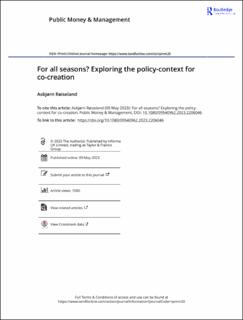For all seasons? Exploring the policy-context for co-creation
Peer reviewed, Journal article
Published version
Permanent lenke
https://hdl.handle.net/11250/3097700Utgivelsesdato
2023Metadata
Vis full innførselSamlinger
- Publikasjoner fra Cristin [3269]
- SAM - Handelshøyskolen [392]
Sammendrag
MPACT
‘Co-creation’ is a major buzzword in contemporary governance. A range of public sector
organizations nowadays declare co-creation as an overall strategy for their policies and actions.
However, what co-creation should mean in operational terms often remains less clear. This article
explores what co-creation could look like within three significantly different policy contexts: the
exercise of authority, service delivery and regulation. To illustrate the argument, the article also
explores the extent to which co-creation as a practice already exists in three Norwegian policy
fields which resemble the three policy contexts. These three policy fields are child welfare and
protection (authority), elderly care (service delivery) and climate policy (regulation). Although the
illustrative examples are derived from a single country, they will be relevant to other countries as well.
ABSTRACT
Co-creation is a broad concept that can potentially be applied to many significantly different policy
contexts. However, the co-creation literature has paid less attention to questions like how policy
content conditions co-creation, and how this generic idea can be translated into different policy
fields. To address this gap, this article aims to explore what co-creation might mean in different
policy contexts, and discusses co-creation in the context of legal authority, service provision and
regulation. The arguments are illustrated using examples from three Norwegian policy sectors:
child welfare, elderly care, and climate policy.

